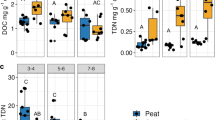Abstract
The time for half of the total oxidizable carbon to be converted into CO2 and other gaseous products (t1/2) was studied for five tree species used in agroforestry. The study was conducted in a perfusion system with continuous aeration, and moisture content maintained at field capacity. This method was found to be suitable for studies of the initial stages of tree foliage decomposition. The overall rate was in the decreasing order: Leucaena>Calliandra>Gliricidia>Prosopis>Cassia. Decomposition started rapidly and then decreased rapidly for 2 to 3 weeks followed by a gradual decrease which continued for the remainder of the time.
The time for 50 per cent of total oxidizable carbon to decompose was about 19 days for Leucaena, 30 days for Calliandra and Gliricidia, while Prosopis and Cassia took more than 30 days. Leucaena released the largest quantity of total N into the perfusing solution while Cassia gave the lowest amount.
Similar content being viewed by others
References
Alexander M 1977 Organic matter decomposition. In Introduction to Soil Microbiology, 2nd ed. pp 128–146 Wiley, New York.
Bremner J M 1965 MacroKjeldahl methods to include nitrate. In Methods of Soil Analysis, Part 2, Chemical and Microbiological Properties, Ed. C A Black. Agron. No. 9, Madison, WI.
Buckman H O and Brady N C 1971 The Organic Matter of Mineral Soils: The Land Properties of Soils, 7th ed. pp 132–160. Macmillan, London.
Kang B T and Duguma B 1984 Nitrogen management in alley cropping systems. Paper presented at the International Symposium on Nitrogen Management in Farming Systems in the Tropics. IITA. Ibadan, Nigeria, 1984, 17 p.
Keya S O 1975 Microbiology Practicals. Technical Comm. No. 6. Dept of Soil Sci., Univ. of Nairobi 22 p.
Nyamai D O 1987 Crop Production in an Intercropping System with Tropical Leguminous Trees. Thesis (D. Phil.), University of Oxford.
Sprent J I 1983 Agricultural and horticultural systems: Implications forestry. In Biological Nitrogen Fixation in Forest Ecosystems: Foundations and Applications. Eds. J CGordon and C TWheeler, pp 213–232. Nijhoff/Junk, The Hague, The Netherlands.
Tester C F, Sikora L J, Taylor J M and Parr J F 1977 Decomposition of sewage sludge compost in soil. 1. Carbon and nitrogen transformations. J. Environ. Quality 6, 459–463.
Watt-Smyrk J S 1981 Studies on the Initial Degradation of Sludge in Soil. Thesis (D. Phil.), University of Oxford.
Weeraratna C S 1979 Patterns of nitrogen release during decomposition of some green manures in a tropical alluvial soils. Plant and Soil 53, 287–294.
Author information
Authors and Affiliations
Rights and permissions
About this article
Cite this article
Nyamai, D.O. Investigations on decomposition of foliage of woody species using a perfusion method. Plant Soil 139, 239–245 (1992). https://doi.org/10.1007/BF00009315
Received:
Issue Date:
DOI: https://doi.org/10.1007/BF00009315




